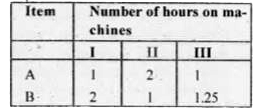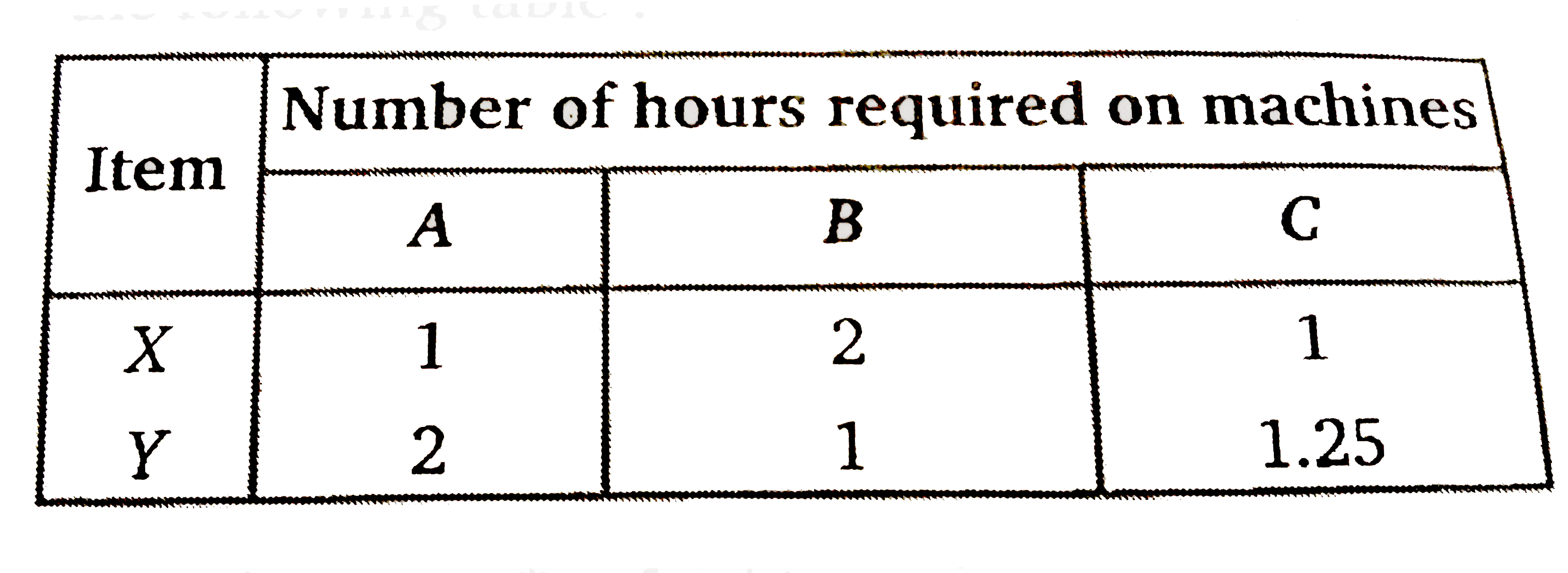A manufacturer has 3 machines I, II and III installed in his factory. Machines I and II are capable of being operated for utmost 12 hours whereas machine III must be operated atleast for 5 hours a day. He produces only two items A and B each requiring the use of three machines. The number of hours required for producing 1 unit of each of the items A and B on the three machines are given below.

He makes a profit of Rs 7600 on item A and Rs 400 on item B. Assume that he can sell all that he produces.
(i) Formulate this as a linear programming problem.
(ii) Solve the L.P.P by corner point method.Solution in Tamil
Step by step video & image solution for A manufacturer has 3 machines I, II and III installed in his factory. Machines I and II are capable of being operated for utmost 12 hours whereas machine III must be operated atleast for 5 hours a day. He produces only two items A and B each requiring the use of three machines. The number of hours required for producing 1 unit of each of the items A and B on the three machines are given below. He makes a profit of Rs 7600 on item A and Rs 400 on item B. Assume that he can sell all that he produces. (i) Formulate this as a linear programming problem. (ii) Solve the L.P.P by corner point method. by Maths experts to help you in doubts & scoring excellent marks in Class 12 exams.
Topper's Solved these Questions
- BOOK - NEW JOYTHI PUBLICATIONCHAPTER - LINEAR PROGRAMMING EXERCISE - NCERT MISCELLANEOUS EXERCISE10videos
LINEAR PROGRAMMING
- BOOK - NEW JOYTHI PUBLICATIONCHAPTER - LINEAR PROGRAMMING EXERCISE - UNIT TEST6videos
LINEAR PROGRAMMING
- BOOK - NEW JOYTHI PUBLICATIONCHAPTER - LINEAR PROGRAMMING EXERCISE - NECERT TEXT BOOK EXERCISE 12.210videos
LINEAR PROGRAMMING
- BOOK - NEW JOYTHI PUBLICATIONCHAPTER - LINEAR INEQUALITIESEXERCISE - QUESTIONS FROM COMPETITIVE EXAMS38videos
LINEAR INEQUALITIES
- BOOK - NEW JOYTHI PUBLICATIONCHAPTER - MATHEMATICAL REASONINGEXERCISE - QUESTION FROM COMPETITIVE EXAMS23videos
MATHEMATICAL REASONING
Similar Questions
A dietician has to develop a special diet us ing two foods P and Q. Each packet (containing 30g) of food P contains 12 units of calcium, 4 units of iron, 6 units of cholesterol and 6 units of vitamin A. Each packet of the same quantity of food Q contains 3 units of calcium, 20 units of iron, 4 units of cholesterol and 3 units of vitamin A. The diet requires atleast 240 units of calcium, atleast 460 units of iron and almost 300 units of cholesterol. How many packets of each food should be used to maximise the amount of vitamin A in the diet? What is the maximum amount of vitamin A in the diet?
08:39View SolutionA company combines two items A and B from gift packs during a festival season. Each pack must weight atleast 5 kg and should contain atelast 2 kg of A and not more than 4 kg of B. The net contribution of the company is Rs. 10 per kg of A and Rs 12 per kg of B. the company wants to determine the optimum mix. By defining suitable variables, write
i. the objective function
ii. The constraints05:24View SolutionReshma wishes to mix two types of food P and Q in such a way that the vitamin contents of the mixture contain atleast 8 units of vitamin A and 11 units of vitamin B. Food P costs Rs. 60// kg and food Q cost Rs. 80/kg. food P contains 3 units/ kg of vitamin A and 5 units/ kg of vitamin B while food Q contains 4 units/kg vitamin A and 2 units/kg of vitamin B. Determine the minimum cost of the mixture .
View SolutionThe set of all x satisying the inequility 4x−13x+1≥1 is
View SolutionThe statement ~(p→q) is equivalent to
03:35View Solution(Manufacturing problem) A manufacturer has three machines I, II and III installed in his factory. Machines I and II are capable of being operated for at most 12 hours whereas machine HI must be operated for atleast 5 hours a day. She produces only two items M and N each requiring the use of all the three machines. The number of hours required for producing 1 unit of each of M and N on the three machines are given m the following table:She makes a profit of Rs 600 and Rs 400 on items M and N respectively. How many of each item should she produce so as to maximise her profit assuming that she can sell all the items that she produced? What will be the maximum profit?
04:27View SolutionA manufacturer produces nuts and bolts. It takes 1 hour of work on machine A and 3 hours on machine B to produce a package of nuts. It takes 3 hours on machine A and 1 hour on machine B to produce a package of bolts. He earns a profit of Rsl7.50 per package on nuts and Rs 7.00 per package on bolts. How many packages of each should be produced each day so as to maximise his profit, if he operates his machines for at the most 12 hours a day?
View SolutionA manufacturer has three machines A,B and C installed in his factory. Machines A and B are capable of being operated for atmost 12 hours whereas machine C must be operated for atleast 5 hours a day. He produces only two items X and Y each requiring the use of all the three machines. The number of hours required for producing 1 unit of each of X and Y on three machines are given in the following table:

He makes a profit of Rs. 600 and Rs. 400 on each item of X and Y respectively. How many of each item should he produce so as to maximize his profit assuming that he can sell all the items that he produced?04:16View SolutionA manufacturer produces nuts and bolts. It takes 1 hour of work on machine A and 3 hours on machine B to produce a package of nuts. It takes 3 hours on machine A and 1 hour on machine B to produce a package of bolts. He earns a profit of Rs. 17.50 per package on nuts and Rs. 7.00 per package on bolts. How many packages of each should be produced each day so as to maximise his profit, if he operates his machines for at the most 12 hours a day?
16:29View SolutionA factory has two Machines - I and II. Machine-I produced 60% if items and Machine - II produces 40% of the items of the total output. Further 2% of the items produced by Machine - I are defective whereas 4% produced by Machine - II are defective. If an item is drawn at random what is the probability that it is defective ?
09:58View SolutionA factory has two Machines - I and II. Machine - I produces 60% of items and Machine -II produces 40% of the items of the total output . Further 2% of the items produced by Machine-I are defective whereas 4% produced by Machine -II are defective . If an item is drawn at random what is the probability that it is defective ?
01:17View Solution(Manufacturing problem): A manufacturer has three machines. I, II and III installed in his factory. Machines I and II are capable of being operated for at most 12 hours whereas machine III must be operated for atleast 5 hours a day. She produces only two items M and N each requiring the sue of all the three machines.
The number of hours required for producing 1 unit of each of M and N on the three machies are given in the follownig table:

She makes a profit of Rs. 600 and Rs. 400 on items M and N respectively. How many of each item should be produce so as to maximise her profit assuming that she can sell all the items that she produced? What will be the maximum profit?07:50View Solution(Manufacturing problem): A manufacturer has three machines. I, II and III installed in his factory. Machines I and II are capable of being operated for at most 12 hours whereas machine III must be operated for atleast 5 hours a day. She produces only two items M and N each requiring the sue of all the three machines.
The number of hours required for producing 1 unit of each of M and N on the three machies are given in the follownig table:

She makes a profit of Rs. 600 and Rs. 400 on items M and N respectively. How many of each item should be produce so as to maximise her profit assuming that she can sell all the items that she produced? What will be the maximum profit?09:07View SolutionA manufacturer produces nuts and bolts. It takes 1 hour of work on machine A and 3 hours on machine B to produce a package of nuts. It takes 3 hours on machine A and 1 hour on machine B to produce a package of bolts. He earns a profit of Rs 17.50 per package on nuts and Rs 7.00 per package on bolts. How many packages of each should be produced each day so as to maximise his profit, if he operates his machine for at most 12 hours a day?
15:02View SolutionA manufacturer produces two products A and B. Both the products are processed on two different machines. The available capacity of first machine is 12 hours and that of second machine is 9 hours per day. Each unit of product A requires 3 hours on both machines and each unit of product B requires 2 hours on first machine and 1 hour on second machine. Each unit of product A is sold at Rs. 7 profit and that of B at a profit of Rs. 4. Find the production level per day for maximum profit graphically.
06:04View Solution

